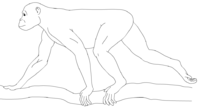Proconsul africanus
| Proconsul africanus Temporal range: Miocene
| |
|---|---|

| |
| Scientific classification | |
| Kingdom: | |
| Phylum: | |
| Class: | |
| Order: | |
| Superfamily: | |
| Family: | Proconsulidae (extinct)
|
| Subfamily: | Proconsulinae (extinct)
|
| Genus: | Proconsul (extinct)
|
| Species: | P. africanus
|
| Binomial name | |
| Proconsul africanus | |
Proconsul africanus was a Miocene-era fossil found on Rusinga Island by Mary Leakey and her research team. Pieces of this fossil had been found before but Mary Leakey's find was more complete. The 18 million year old fossil is a possible ancestor of both great and lesser apes, and humans.
The paleontologist Louis Leakey, who was one of the foremost fossil-hunters of the twentieth century and a champion of evolution, described this ape: "An especially important creature was Proconsul africanus. This, many authorities once concluded, gave us an indication of the common stock for apes and men. We have good forelimb bones for it, and in 1948 on Rusinga Island Mary [Leakey] discovered a skull, the first nearly complete specimen ever found. Its canine teeth suggest an ape's, while its forehead reminds us of our own. It seems to me, however, to be neither an ancestral ape, nor yet an ancestor of man, but a side branch with characteristics of both stocks..."
Morphology
The Proconsul africanus had a dental formula of 2:1:2:3 on both the upper and lower jaws. The molars of this species had thin enamel and there was a prominent molar cingula. This species also possessed a robust zygomatic bone and a pronounced snout. This species had a broad interorbital region and small frontoethmoidal sinuses. The maxillary sinus was restricted. This species had an auditory region which would be similar to that of extant apes and cercopithecoid monkeys. The ectotympanic tube was well-developed. This species lacked a tail and the canines of this species were sexually dimorphic. The skull lacks supraorbital tori and can be considered somewhat prognathous. This species has a cranial capacity of 167 cc and an encephalization quotient of 1.5. Based on the cranium, this species had an external brain surface much like that of gibbons and cercopithecoid monkeys. The wrist of this species has been described as monkey-like. This species has a talus in which the trochlear surface is highly curved and deeply grooved. The foot of this species possessed a transverse arch. Proconsul africanus had a brachial index of 96 which is comparable to the extant genus Pan. Overall the skeleton of this species can be described as being robust. This species had an average body mass of around 18 kilograms.
Diet
Based upon the dental morphology, it is assumd that Proconsul africanus was a frugivorous species.
Range and Locomotion
The fossil remains were found in Africa and based on postcranial pieces, Proconsul africanus was likely an arboreal quadruped.
